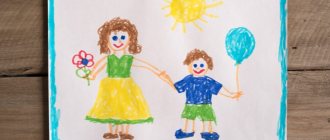In this article:
- Assessing a child's condition using drawing psychology
- Drawing color in child psychology
- Important points in analyzing a child’s drawing
- Decoding the drawing “My Family” in child psychology
The psychology of a child’s drawing allows us to better understand his inner world. In these scribbles, as if in a mirror, the baby reflects everything that is going on in his soul: his personality, his dreams and aspirations, his desires and even fears. By studying the drawing, a child psychologist can also give an assessment of the child’s level of development, since his insufficient speech apparatus does not always allow him to express himself and his thoughts.
Typically, the most informative in psychology are the drawings of children aged 4.5-5 years. At this time, the scribbles become complete and already carry a semantic load. At the same time, color is not a means of representation, but a way to describe a mood. But how to correctly interpret a baby’s drawing? And is it worth worrying if alarming red and black colors predominate in children's creativity? Let's figure it out.
Assessing a child's condition using drawing psychology
Children do not know how, and sometimes do not want to talk about their personal experiences. They transfer their entire inner world onto paper, where, with the help of pencils, felt-tip pens or paints, they express their emotions, show their attitude towards some event, and determine their place in the world around them. Therefore, attentive and caring parents, understanding the psychology of the child’s drawing, discussing with him the details of the plot and the characters depicted, will be able to better understand his inner world. And at this moment the baby will try to convey his thoughts and feelings to adults, thereby developing speech, logic, and replenishing his vocabulary. Secret dreams and secrets, relationships with peers, worldview - parents will learn all this if they listen to the little artist’s story about what he depicted on paper.
- Analysis of the plot of the drawing and its completeness
This point is extremely important for studying the inner “I” of children of any age. Children under 5 years old draw schematically, without thinking about the details. This is due to age-related mental characteristics. Older children draw schematically if at the moment they have no interest in this activity. But they can portray invented characters that reflect the state of their inner world. Unusual stories speak of children's good imagination and creativity. If a son or daughter produces only abstract pictures that are in no way connected with the surrounding reality, then parents should be concerned about the psychological state of their child. Such images indicate that the little person has problems communicating with peers, has no true friends, and is not satisfied with his own situation.
Everything that a child considers important and most significant for himself, he draws large, sometimes violating all proportions. And he portrays small things that don’t mean much to him.
The plot of a child’s drawing and the characters depicted on paper must be interpreted extremely carefully so as not to be mistaken about the child’s emotional state. The kid can draw a smiling monster, which only speaks of his playful, humorous mood.
The theme of the picture also depends on the gender of the child.
The theme of the picture also depends on the gender of the child. Boys are cars, planes, ships, and also war and soldiers. Girls often draw princesses in luxurious dresses, butterflies, and flowers. When the drawing is finished, talk to the young artist - who is depicted on it, what his character is thinking about, whether he is happy or sad. The author's positive mood and peace of mind are reflected in the sketches of nature - the sun, forest, river, grass.
- Analysis of the location of a drawing on a sheet of paper
A sheet of paper is a whole world for a child, so it is very important what part of it the child’s drawing occupies. Children who are comfortable and comfortable in this life will place their plot in the very center of the sheet. A timid, shy kid will make the details of the drawing small. And in general, a small picture is a child’s low self-esteem. But children with high self-esteem will draw in the center of the sheet, but in such a way as to fill all the free space.
It is also worth paying attention to how the children's drawing is located vertically from the center.
If it is shifted to the upper plane, then this speaks of leadership qualities, the desire to dominate others, to keep the situation under control. Accordingly, the picture at the bottom of the sheet speaks of passive behavior, uncertainty, and dependence on the environment.
The plot shifted to the right indicates a desire for the future. This is typical for active and determined extroverts who place mind and intellect above emotions. Introverts often draw on the left half; they are attracted to the past. These are very emotional children, dreamers, they don’t want to grow up for a long time.
- Line analysis
The lines that a little artist draws with a pencil can tell a lot about his nervous system. An active, dynamic child in a cheerful state draws with strong pressure, confidently marking the contours. Uncertain, trembling lines, weak pressure are characteristic of a constrained, insecure baby. Either he is tired, not only physically, but also emotionally. In children with an impulsive character, pressure changes depending on their mood, becoming either strong or weak.
If you notice that some detail on the paper is highlighted brighter, the lines are drawn with stronger pressure, then keep in mind that the child associates an emotional uplift with this detail. For example, he can densely shade and paint over the mouth of a drawn mother or grandmother, because he often hears shouts and comments from them.
Patches and crosses
Patches on parts of a person’s body that are not typical in appearance, intertwined arms or legs. If such details are repeated regularly, the child may be worried about illness. The patches are usually located at the site of the organ that hurts.
Delicious psychology. How do eating habits affect a child's character? More details
Drawing color in child psychology
Studying the connection between colors and human behavior, the famous psychologist Max Luscher proved that certain color preferences can tell a lot about the physical and mental state of people. Based on a person’s choice of one color or another, one can determine his character, emotional state, and other behavioral characteristics.
In psychology, each color has a clear characteristic, but there are always exceptions to the rules. After all, people perceive certain shades differently. Before drawing conclusions, try to clarify with your child how he sees this color - cheerful or sad, what thoughts it evokes.
Psychology of family life: healing relationships
The article will tell you how to make family relationships harmonious
Read >
Children use at least 5-6 colors in the drawing process, this is the norm.
Children use at least 5-6 colors in the drawing process, this is the norm. The more confident children feel, the brighter the colors they choose. But kids are spontaneous, so you shouldn’t draw clear conclusions. The baby painted his dad with black strokes because he often sees him in his favorite black sweater. But he can also highlight dad as black if he left the family. When 1-2 colors clearly predominate in the drawings, then it is worth paying attention to this.
Many specialists in their work are guided by the interpretation of color developed by Max Luscher, a famous psychologist and researcher in this field. His findings suggest that unconscious color preference speaks not only about a person’s psychological state, but also about his physical health.
Having studied the psychology of drawing by a 5-year-old child, you can use Max Luscher’s technique to analyze the presence of a particular color in the children’s works.
- dark blue – withdrawal, focus on internal problems, need for peace;
- green – balance in feelings, poise, independence, perseverance, desire for security;
- red – desire for aggression, strong willpower, increased activity, excitability;
- yellow – optimistic attitude towards life, positive emotions, spontaneity, curiosity;
- purple – a creative person with developed imagination and intuition, but at the same time emotional and intellectual immaturity (children often prefer this color);
- brown – often embodies negative emotions, determines the sensory support of sensations, slowness, physical discomfort;
- black is the color of protest, depression, destruction, an urgent need for change;
- if a child uses only a simple pencil, without trying to color the drawing, this indicates indifference, detachment, and a desire to close himself off.
What do parents need to know about the development of children's drawings?
Before you begin to interpret the drawings, you need to find out what you can expect from a child of a given age. In their development, children's drawings go through several stages:
| Age | Contents of drawings |
| Up to 1.5 years | Stroke stage. At this age, children enjoy the colorful marks they can leave on paper. |
| 1.5 – 3.5 years | Doodle stage. The drawings made by children at this age do not differ in appearance from the drawings of the previous stage, but the child already puts his own meaning into them, wanting to depict something specific. |
| 3.5 – 8 years | Schematic stage. The child depicts only the important details of the object, without taking into account the proportions. |
| 8 – 10 years | Stage of plausible images. Children at this age try to depict the object as accurately as possible, details are drawn, proportions are taken into account. |
| After 10 years | Correct images. The drawings become three-dimensional and realistic. |
You should not seriously analyze the drawings of children under four years of age, since a child of this age does not yet have sufficiently developed fine motor skills to be able to express what he wants on paper.
Of particular importance are the features of the image of a person:
| Age | Features of the image of a person |
| Up to 3 years | “Cephalopods” are a round body, arms and legs are sticks. |
| 4 years | The body is usually round or oval, there is no neck. The proportions are not respected. |
| 5 years | Gender differences appear (girls and boys are depicted differently), details (ears, hair, clothes). |
| 6 years | Drawing small details, maintaining proportions. The neck and fingers are depicted. |
| 7 years | The drawing becomes more realistic. The face can be drawn not only from the front, but also from the profile. |
| 8 years | The line of the neck, shoulders and arms is continuous. |
| 9 years | A person can be depicted in various poses, and movement is captured. |
| 10-11 years | The desire to create a three-dimensional image. |
Important points in analyzing a child’s drawing
- You can analyze the color scheme of a drawing only if the child had the entire palette of pencils at his disposal. A picture in dark colors can also be obtained because next to the young artist there were only these colors. If the child only has a simple pencil in his hands, then you don’t have to worry about the plot being a little gloomy.
- Do not try to analyze work done in kindergarten. Most often, children are given a specific topic to draw on, which deprives them of freedom of expression.
- We should not forget that the content of the drawing directly depends on the mood of the children, their state of mind at the time of drawing. If the child had a conflict literally before the start of the lesson, or he simply did not get enough sleep, then all the grievances, emotions, and fatigue will definitely “spill out” on paper, which will help him relieve nervous tension. This is why art therapists use drawing as the most effective way to release negative emotions.
- The content of children's artistic creativity is not always obvious to an adult. Therefore, it is necessary to correctly discuss his work, clarify with the child what is happening with the drawn characters, how it will all end. And only then will you be able to correctly interpret what he depicted.
- A simple question: “What did you draw here?” can cause a wave of indignation and even offend the young artist. After all, it is obvious to him. Don’t try to guess, it’s unlikely to work, because everyone perceives the picture in their own way. It’s better to let him tell you what he depicted, and you just carefully ask clarifying questions.
- Refrain from jumping to conclusions (How similar to a cat!), this is unlikely to be a correct assumption. Do not criticize, but also do not praise in general, without specific facts (What a beauty, you are a wonderful artist!).
- The child is interested in the process of drawing, what and how he does, so pay attention to how he draws (What an unusual background you have! What do you want to draw on it?)
Images of people
Parents are often frightened when their child draws people without faces or without legs, even though he already knew how to depict full-fledged human figures. Such drawings can reflect the child’s real relationship with this person. For example, if an older brother has no eyes and no hands, perhaps the child does not want him to see him taking his things and punish him for it. If dad is drawn so “flawed”, maybe the child does not agree with his demands and prohibitions. Usually, in a child’s drawing of a family, the most important member of the family, in the child’s opinion, is depicted above everyone else.










